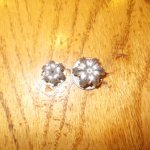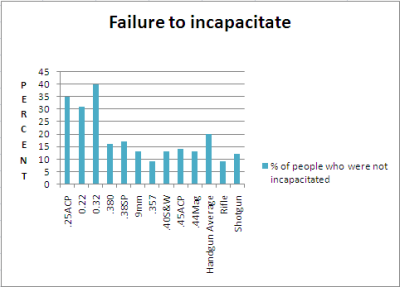It's not "faster" John, it's a higher percentage of one shot stops.
Fair enough. So using the data you're referencing, what's the real-world difference in the percentage of one shot stops between the two cartridges?
That is what the TENDS means.
I know what "tends" means and that's the problem. It doesn't provide any useful information. Since terminal effect isn't the only variable affected by caliber choice, common sense tells us to weigh all the different variables and make a reasonable choice based on the available evidence.
We should run through a thought process something like the following...
So, if I'm giving up capacity, or having to go to a larger handgun, what am I getting for it? If I'm giving up shooting performance due to higher recoil/muzzle rise/slower splits, what am I getting for it? If my ammo and practice costs go up, what do I get in return?
I get a "tendency" towards better incapacitation.
Ok, how much of a tendency? Is it worth giving up 3 rounds of capacity, paying 15% more for ammo and going to a carry gun that's 2 oz heavier? What about paying 20% more for ammo, giving up 5 rounds and going to a gun that's 5oz heavier? Is it worth going from a consistent ability to make par on a Bill Drill to failing to do so 50% of the time?** What about if all that's given up is 5 rounds of capacity?
Well, the experts say that the tendency is so small that no one has been able to accurately quantify it. One expert speculated it might make a difference in 1 out of a hundred shootings. In fact, it's so small that one of the best funded LE agencies in the world states that they see no reason to concern themselves with it any longer.
Hmmm. If the tendency is so small it can't be accurately quantified then why would I give up ANYTHING to gain it?
The fact is that even "over thousands of shootings" the one thing that has become clear is that the
practical effect on stopping power/incapacitation due to terminal performance differences among the service pistol calibers is small. So small that the other variables involved swamp it and make it impossible to not only quantify accurately but also to even verify that a
practical effect actually exists with any level of confidence.
As the caliber rose, more and more tended to have to be carried in.
I think everyone agrees that if you look at the entire handgun caliber spectrum from .22 short up to .500Mag that there will be a
practically significant difference in terminal performance. What we're talking about here is comparing a narrow performance range--just the service pistol calibers.
**Performance Center Pocket Rocket
Smith & Wesson's Popular M&P Shield gets a new ported barrel, fiber-optic sights and a great trigger for less than $500.
January 2016 Guns & Ammo Magazine
by Patrick Sweeney
<The article is a review of two identical ported M&P Shields from the Performance Center, one in 9mm & the other in .40S&W.>
Take for example the classic Bill Drill, which is to draw and fire six rounds on an IPSC target at 7 yards. With 9mm, I could readily shoot a par score: six A hits in two seconds flat. With the .40, I was about 50/50, either going over time or pushing a shot out of the A zone.



